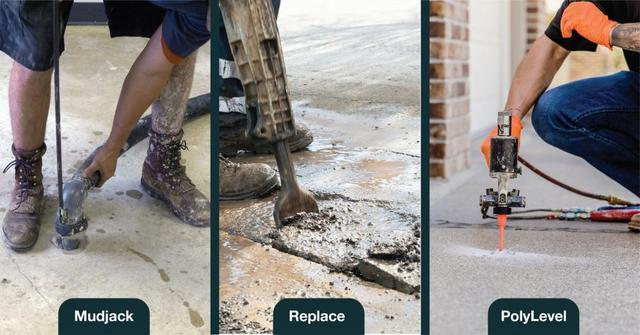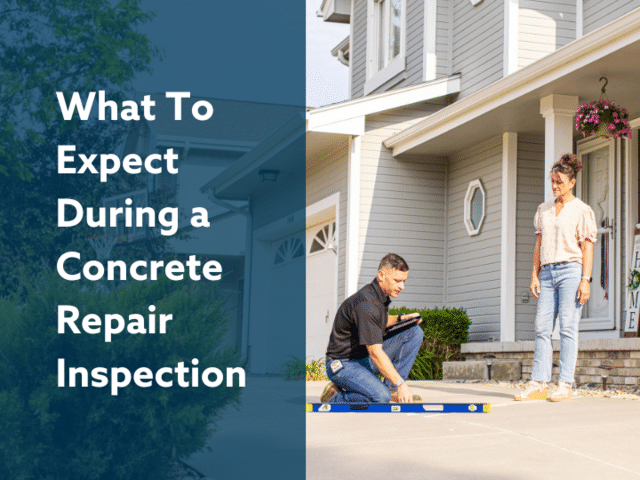Is It Better To Repair Or Replace Your Concrete? Our Expert Advice

Concrete is the most popular material for driveways and walkways. It’s strong, durable, and requires little maintenance.
But like most materials, it wears down over time. It’s inevitable.
Just like we show age with wrinkles and gray hair, concrete shows age with cracks and holes.
When homeowners see these signs in their driveway or walkways, they might think it’s time to replace them. But that’s not always the case. Concrete repair is a great way to revitalize your slabs.
But how do you know if you should be repairing or replacing it? Let’s dive in.
First things first: why does concrete fail?
To know if you need to repair or replace your concrete, you need to understand what exactly is damaging your concrete. And there are three big reasons most concrete fails.
1. Changing temperatures
Concrete’s number one enemy is the weather. Temperature changes can cause concrete to expand and contract.
In warm weather, concrete expands, and when it cools, it shrinks.
When concrete contracts, the joints, and cracks widen, collecting pebbles, sand, and other debris. And then, once it gets warm and the concrete expands, it grows in size.

2. Poor soil conditions
Land developers and builders moved the soil on your property to prepare the site for construction.
This created an additional top layer of fill soil.

Your concrete slabs were then poured over these areas of fill. And that fill, even if it was compacted very well, is not as stable as the native soils below.
So when fill soils consolidate and settle, voids form under the concrete slab. And eventually, that slab cracks and falls into these voids.
3. Water
Concrete is a giant sponge.
When it rains, concrete’s pores absorb every ounce of water. And when the sun comes out, the water evaporates. This constant absorption and evaporation cycle causes spider-cracking at the concrete’s surface.

It’s a common myth that salt deteriorates concrete. But it’s not the salt. Instead, it’s the premature freezing and thawing that causes water to re-freeze and causes damage.
Option 1: Repairing your concrete
In the last ten years, concrete repair kind of had a bad rap. Most people would opt to replace their concrete over repairing it.
But with new technology and better systems in place, repairing your concrete is now more common. It’s less invasive, more affordable, and quicker than total replacement.
The process
Repairing your concrete is quick and straightforward nowadays, but it didn’t use to be.
No more mudjacking
Mudjacking, for the longest time, was the only method to repair concrete. It involved mixing soil with concrete and creating a “mud” that’s injected under the concrete slabs to lift and level them to their original placement.
It was messy, chaotic, left injection holes, and unfortunately failed to address the actual cause of the damage: the soil not appropriately compacted.

PolyLevel is the new way
But now, most concrete repair uses PolyLevel.
It refers to a system that uses a two-part polyurethane polymer to fill voids and lift concrete slabs to their original position. It’s injected through a pencil eraser-sized hole and expands into a structural foam that compacts the soil.
It’s quick, noninvasive, aesthetically pleasing, requires little clean-up, and doesn’t retain moisture.

PolyLevel solves the underlying problem: the soil not being compacted properly.
It's inserted beneath sinking, cracked concrete through tiny ports. Then, it flows like water to fill even the most minor cracks and crevices in the soil.
The PolyLevel foam then expands and hardens, lifting the slab and compressing the surrounding soil.
The best part about PolyLevel is the installation process is extremely fast. The material itself also cures in 15-20 minutes, so the surface can be used within the same day.

When it makes sense to repair
Here are some reasons to repair your concrete over total replacement.
Cracks. Cracks in concrete can be caused by freeze-thaw cycles, poor construction, and age. NexusPro is easily used to fill and seal cracks and control joints.
Settled and unlevel slabs. Settled concrete is most likely occurring because of poor soil conditions. And settled concrete can be a huge safety issue and tripping hazard. Luckily, these are easily fixed with PolyLevel.
Sunken steps. Front stoops and concrete steps sink and settle over time. But fortunately, they can be leveled, filled, and sealed to prolong their life.
Why would you repair the concrete?
There are several reasons repairing concrete makes more sense than replacing it entirely.
- Safety is a huge one. We've all tripped or seen a loved one trip. Tripping hazards are especially dangerous for small children and older people, so it's a huge motivator to get it repaired.
- It's more affordable than replacing.
- Your slab will only get worse with time. Concrete problems don't go away; they just get worse.
- Looking to sell your home? A concrete repair is like a facelift for your house and instantly increases your home value and curb appeal.
- Believe it or not, your settling concrete can affect your home and cause structural and water damage. Structures connected to the slab may crack and settle, too. That includes your home's foundation, doors, and windows.
Option 2: Replacing your concrete
A concrete replacement refers to removing the entire slab, then replacing it with a new one.
The process of replacing your concrete is disruptive, long, and inconvenient. Which is why we always try to repair when we can.
But sometimes, the damage is too much, and replacement is more cost-effective.

The process
To replace concrete, the first thing that needs to happen is the removal of the existing concrete. Which is usually done by jackhammering the slab into tiny pieces.
Unfortunately, this means lots of dust, dirt, noise, and heavy equipment on your property. And a dumpster to place the pieces of concrete in.
The next step is preparing the base with new soil and pouring the new slab, often involving delivery trucks and heavy concrete bags.
After that, there’s a curing process where you have to wait before you put any weight on it. New concrete takes about 24-48 hours to dry, but it has a 28-day curing period. That means you have to wait about a month before you can park your car on your new driveway or walk on your new sidewalk.
As you can see, replacing your concrete is not an easy, painless process. It’s disruptive, expensive, and requires a lot of labor, time, and materials. But sometimes, it’s necessary.

When it makes sense to replace
Here are some reasons to replace your concrete instead of repairing it.
If your concrete is older than 30 years. Concrete that experiences a lot of wear-and-tear (like sidewalks and driveways) has a lifespan of about 25-50 years. Repairing does help prolong the concrete’s life cycle. But suppose your concrete is already up there in age and not looking so good. In that case, a full replacement might be the better option and a good investment in your property.
Deep cracks and large potholes. The rule of thumb is that if your concrete is sinking more than 8”, it makes more sense to replace it.
Poorly installed base. Sometimes, your concrete issues come down to how it was installed, and no amount of repairs can solve that problem.

Other factors to consider
Ask yourself these questions if you are still on the fence:
How much time do you have?
Replacing concrete can take over a week to complete, plus there’s a 28-day period where you can’t put any weight on your new slab. Whereas repairing can be done in a single day and used immediately after.
What's your budget?
Repairs are, hands-down, more affordable than a full replacement. But don’t forget to consider how old your concrete is. If it’s older, and you choose to repair over replace, you might be repairing it annually. In that case, replacement might be more cost-effective and a better long-term solution.

Not sure what’s best for you?
The best advice we can give is to reach out to a concrete professional. Having a knowledgeable company walk you through the process is key to knowing all of your options and reaching the best solution for you and your concrete.
At Thrasher, we exist to help and give you the knowledge and tools you need to make the best choice for your home. We walk each customer through our process, so they feel comfortable and confident in our ability to get the job done. If you want a thorough inspection or just have questions about concrete repair, call us at 402-313-3068 or message us, and we'll reach out to you.
Article Categories:



